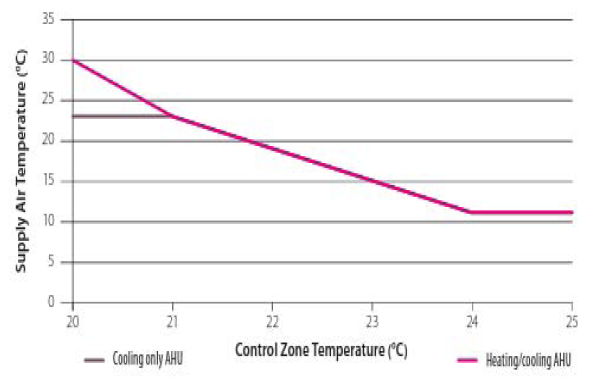
Does Supply Air Temperature Reset Control Strategy Saves Energy?
One of the control strategies for the HVAC system that should save energy is the supply air temperature reset. By this strategy and during the cooling mode for example, the controller increases the supply air temperature in the AHU when the cooling load in the building decreases. By this way, we decrease the load on the chiller, which leads to reduction in its energy consumption. This strategy work very well and for sure saves energy in the constant air volume systems but what about the variable air volume (VAV) systems?
In the VAV system, the AHU fan speed decreases when the load decreases in the building to save energy and it is controlled by a pressure sensor in the supply duct. When the VAV boxes start closing due to the low load in the building, the pressure increases in the supply duct and the pressure sensor send a signal to the controller to decrease the fan speed.
From the above we can see that resetting the supply air temperature is fighting the fan speed reduction strategy when the load in the building starts decreasing. So, does the supply air temperature reset strategy really reduces energy consumption? Is the saving in the chiller energy more than the fan energy increase? If we keep the supply air temperature constant without a reset, does the fan energy saving exceeds the energy required for the reheat coils? It is hard to tell unless we measure the actual energy consumption of the system before and after we implement this strategy or we might use energy simulation software to predict the energy consumptions with and without this strategy.
Some BMS (Building Management System) experts say that by implementing supply duct pressure reset strategy and with a good fine tuning to the control system, the supply air temperature reset can work properly and decrease energy consumption.
This can also apply to the supply chilled water temperature reset in variable water flow systems because it has the same concept as the supply air temperature reset. Actually, they are connected together. When we reset the supply air temperature in the AHU because of the low load in the building, the chilled water two-way valve of the AHU start closing. This will send a signal to the controller to reset the supply chilled water temperature, which will fight the strategy of reducing the chilled water pump speed.
If you have anything to add for this blog, please feel free to leave your comment below:
Daniel Moreno
I have been browsing online more than three hours today, yet I never
found any interesting article like yours. It is pretty
worth enough for me. In my view, if all web owners and bloggers
made good content as you did, the web will be a lot
more useful than ever before.